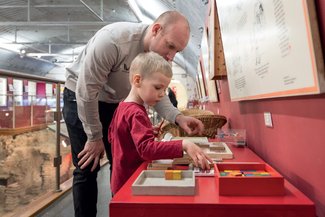Welwyn By Pass Rd, Welwyn, AL6 9FG
Step back in time 1,800 years to discover this fascinating remains of this ancient Roman Bath House.

General Admission
Welwyn Roman Baths is open on Saturdays 10.00am to 4.00pm
The Roman baths beneath the A1(M) in Welwyn, Hertfordshire are a scheduled ancient monument, part of the Dicket Mead Roman villa complex. Discovered in 1960 by Tony Rook, excavations by the Welwyn Archaeological Society revealed a bath complex within a larger villa. This bath house is preserved under the motorway embankment within a steel vault. The villa dates from the early third century and fell out of use in the mid-fourth. The site is open to the public on some Saturdays and on selected days in school holidays, offering family-friendly, hands-on learning and fascinating experiences up close with real archaeology.
The baths feature three key rooms: the unheated frigidarium (cold room), the warm tepidarium, and the hot caldarium. A sophisticated hypocaust system provided underfloor and wall heating. Romans would progress through the rooms, using oil and a curved tool called a strigil for cleansing in the hot room. They’d rinse in plunge pools, hot then cold.
The baths weren’t just about hygiene. For wealthy Romans, bathing was a time-consuming social ritual. It could easily occupy an entire afternoon, combining relaxation with conversations and even business dealings.
